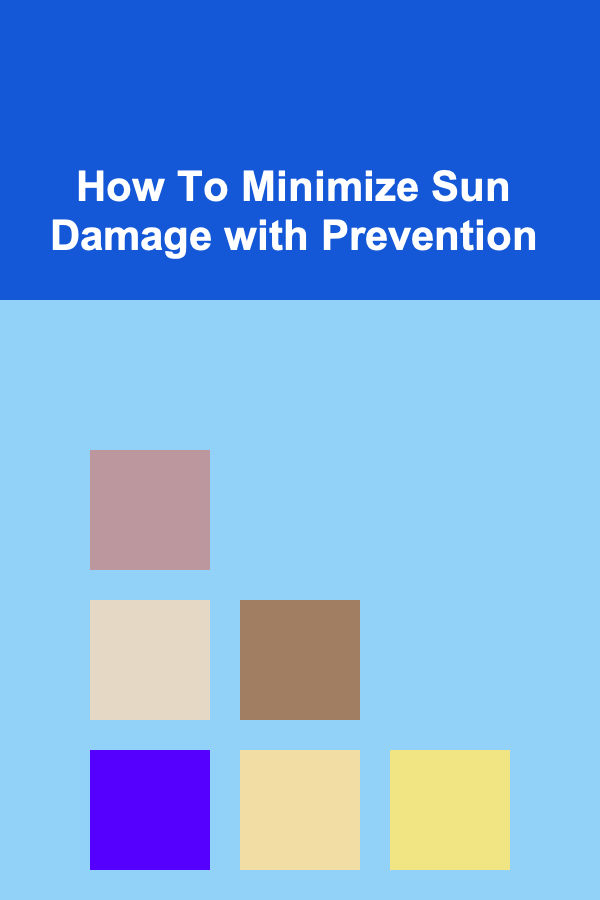
How To Minimize Sun Damage with Prevention
ebook include PDF & Audio bundle (Micro Guide)
$12.99$11.99
Limited Time Offer! Order within the next:

The sun, a vital source of life, provides warmth, light, and energy that sustain our planet. However, prolonged exposure to ultraviolet (UV) radiation from the sun can cause significant harm to the skin, resulting in both short-term and long-term damage. This damage can lead to skin aging, sunburns, and even more serious conditions, such as skin cancer.
Sun damage is cumulative, meaning the more sun exposure you accumulate over your lifetime, the greater the risk of skin damage. While you can't reverse past sun damage, you can take proactive steps to minimize further harm and protect your skin.
This comprehensive guide explores how to minimize sun damage through prevention. We'll cover the science of UV radiation, the risks associated with sun exposure, and the best preventive strategies, from sunscreen to lifestyle changes.
Understanding Sun Damage
Before delving into prevention techniques, it's important to understand the types of damage the sun can cause to the skin. Sun damage results primarily from exposure to UV radiation, which consists of UVA and UVB rays. Each type of radiation affects the skin in different ways.
Types of UV Radiation
-
UVA Rays:
- UVA rays penetrate deeper into the skin and are responsible for causing long-term damage such as premature aging (wrinkles, fine lines, and age spots).
- They also contribute to the risk of skin cancer by damaging the DNA in skin cells.
- UVA rays are present year-round, even on cloudy days and during winter months.
-
UVB Rays:
- UVB rays affect the outer layers of the skin, causing sunburns and contributing to the development of skin cancer.
- These rays are more intense than UVA rays, and their intensity varies depending on the time of day, season, and geographical location.
- UVB exposure is stronger during midday hours (10 AM to 4 PM), especially during the summer months.
Sunburns and Skin Aging
- Sunburns: A visible sign of UVB exposure, sunburn occurs when the skin is overexposed to UV rays, causing redness, irritation, and peeling. It's a temporary reaction, but frequent sunburns can cause long-term damage, increasing the risk of skin cancer and accelerating skin aging.
- Premature Aging: UVA rays penetrate deeper into the skin, leading to the breakdown of collagen and elastin fibers, which are essential for maintaining skin's firmness and elasticity. Over time, this breakdown results in sagging, fine lines, wrinkles, and uneven skin tone.
- Skin Cancer: Both UVA and UVB rays can damage the DNA in skin cells, increasing the risk of skin cancer, particularly melanoma, squamous cell carcinoma, and basal cell carcinoma. Prolonged, unprotected sun exposure is the leading cause of skin cancer.
Preventive Measures to Minimize Sun Damage
Now that we understand the risks, let's dive into the most effective ways to prevent sun damage. Prevention should begin as early as possible, and it involves a combination of physical barriers, lifestyle choices, and proper skincare.
1. Use Sunscreen Properly
Sunscreen is arguably the most important tool in protecting your skin from sun damage. It's essential to choose the right sunscreen and apply it correctly.
Choosing the Right Sunscreen
- Broad-spectrum Protection: Choose a sunscreen that offers protection against both UVA and UVB rays. Broad-spectrum sunscreens provide the most comprehensive defense against harmful UV radiation.
- SPF (Sun Protection Factor): Select a sunscreen with an SPF of at least 30 for daily use. SPF 30 blocks approximately 97% of UVB rays, while higher SPFs provide slightly more protection.
- Water-resistant: If you plan on swimming or sweating, choose a water-resistant sunscreen to ensure that it stays effective longer.
How to Apply Sunscreen
- Amount: Apply sunscreen generously. For the face, use about a nickel-sized amount, and for the body, aim for about one ounce (the size of a shot glass) to cover the entire body.
- Timing: Apply sunscreen 15 to 30 minutes before sun exposure to allow it to absorb properly into the skin.
- Reapplication: Reapply sunscreen every two hours, or more often if swimming or sweating. Sunscreen can wear off over time, especially when exposed to water or friction.
2. Seek Shade
One of the simplest ways to reduce sun exposure is to stay in the shade, especially during peak sun hours, typically between 10 AM and 4 PM when UV radiation is at its highest. If shade is unavailable, consider creating your own shade using umbrellas, wide-brimmed hats, or other protective gear.
3. Wear Protective Clothing
Clothing can serve as a physical barrier between your skin and harmful UV radiation. When spending time outdoors, consider wearing clothing that covers your skin and offers UV protection.
Tips for Protective Clothing:
- Long-sleeved shirts and pants: Look for lightweight, breathable fabrics like cotton or linen that cover your skin but won't cause you to overheat.
- UPF Clothing: Some clothing is designed specifically to block UV rays. UPF (Ultraviolet Protection Factor) clothing offers higher protection, usually ranging from 15 to 50+.
- Hats: Wear a wide-brimmed hat to protect your face, ears, and neck from the sun. A hat with a brim of at least 3 inches is ideal for offering adequate shade.
- Sunglasses: Protect your eyes from UV rays by wearing sunglasses that block 100% of UVA and UVB rays. This helps prevent cataracts, macular degeneration, and other eye issues associated with sun exposure.
4. Avoid Tanning Beds
Tanning beds expose the skin to intense UVA rays, which can lead to significant skin damage. The risk of skin cancer and premature aging is significantly increased by tanning bed use. Avoid tanning beds altogether to protect your skin.
5. Practice Sun Protection Year-Round
Sun protection isn't just for summer months. UV radiation is present throughout the year, even on cloudy days or in cooler weather. Therefore, it's essential to continue practicing sun protection habits year-round.
- Winter Sun Protection: Snow can reflect UV rays, intensifying exposure during winter months, especially at higher altitudes. Be sure to wear sunscreen and protective clothing when skiing or spending time outdoors in the winter.
- Cloudy Days: UV rays can penetrate through clouds, so even on overcast days, it's crucial to wear sunscreen and protective clothing.
6. Maintain Skin Health
Beyond physical protection from the sun, it's essential to nourish and protect your skin's health in general. Hydrated, healthy skin is more resilient to sun damage.
Tips for Maintaining Healthy Skin:
- Moisturize Regularly: Sun exposure can lead to dryness, so it's important to keep your skin hydrated. Use a good moisturizer that suits your skin type, and apply it after sun exposure to help replenish lost moisture.
- Antioxidants: Incorporate antioxidant-rich skincare products that help neutralize free radicals created by UV exposure. Vitamin C, Vitamin E, and niacinamide are excellent options.
- Exfoliate Gently: Regular exfoliation helps remove dead skin cells and promotes the renewal of healthy skin. However, avoid harsh exfoliation, as this can irritate the skin and make it more vulnerable to sun damage.
7. Get Regular Skin Checkups
Regular visits to a dermatologist can help catch any potential skin damage or skin cancers early. A dermatologist can perform full-body skin exams to check for any suspicious moles or growths. Early detection is key to successfully treating skin cancer.
8. Adopt a Healthy Lifestyle
Overall health impacts how your skin responds to sun exposure. A healthy lifestyle supports skin resilience and helps minimize damage from UV rays.
Healthy Habits for Skin Protection:
- Eat a balanced diet: A diet rich in fruits, vegetables, and healthy fats provides essential nutrients for your skin. Omega-3 fatty acids, found in fish like salmon and in walnuts, help maintain skin hydration and elasticity.
- Stay hydrated: Drink plenty of water throughout the day to keep your skin hydrated from the inside out.
- Exercise: Regular physical activity boosts circulation and promotes overall skin health, making your skin more resilient to environmental factors like the sun.
Conclusion
Preventing sun damage is crucial for maintaining healthy, youthful skin and reducing the risk of skin cancer. By incorporating a combination of sunscreen use, protective clothing, lifestyle changes, and regular skin checkups, you can significantly minimize the harmful effects of UV radiation. While it's impossible to reverse past sun damage, these preventive measures will help protect your skin from further harm and ensure that you enjoy the sun safely for years to come.
Start protecting your skin today, and it will thank you in the future.

How to Build a Checklist for Defining Social Media Goals and Objectives: An Actionable Guide
Read More
How to Build a Checklist for Ensuring Compliance During Employee Offboarding
Read More
How to Downsize Your Home Without Sacrificing Comfort
Read More
How to Stay Disciplined and Stick to Your Forex Trading Plan
Read More
How to Tackle Plumbing Upgrades During Your Home Renovation
Read More
How To Master Twists for Detoxification
Read MoreOther Products

How to Build a Checklist for Defining Social Media Goals and Objectives: An Actionable Guide
Read More
How to Build a Checklist for Ensuring Compliance During Employee Offboarding
Read More
How to Downsize Your Home Without Sacrificing Comfort
Read More
How to Stay Disciplined and Stick to Your Forex Trading Plan
Read More
How to Tackle Plumbing Upgrades During Your Home Renovation
Read More